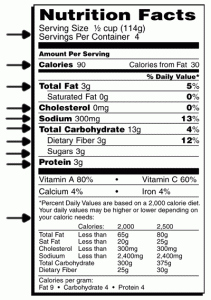How to Read a Label
 One of the things I do is teach people how to eat. When you go grocery shopping the best place to start is the labels on the sides of all the boxes and bags. The ingredients list has always been there. I look for a few things on every label. I want to know that there isn’t anything artificial. The rule of thumb is, if you cannot pronounce it you shouldn’t eat it. They are mostly chemicals and damage your body. The things I avoid every time are anything that says high fructose corn syrup, enriched grains, artificially flavors and colors, all of the FD&C colors, MSG, (even listed as “spices” on ingredients lists).
One of the things I do is teach people how to eat. When you go grocery shopping the best place to start is the labels on the sides of all the boxes and bags. The ingredients list has always been there. I look for a few things on every label. I want to know that there isn’t anything artificial. The rule of thumb is, if you cannot pronounce it you shouldn’t eat it. They are mostly chemicals and damage your body. The things I avoid every time are anything that says high fructose corn syrup, enriched grains, artificially flavors and colors, all of the FD&C colors, MSG, (even listed as “spices” on ingredients lists).
As far as the label, the serving size is at the top, it will give you an idea on how much you can eat in order to get enough good guys – nutrients. It also tells you how to avoid getting too much of the bad guys (sodium, fats…)You will see that this is different on every label. Let’s take crackers. You might see on one that you get 90 mg of sodium in one and 145 in others. Now let’s look at the first one, how many crackers can you eat to get that 90 mg? 11? Now the second box with 145 grams, you might find that you can get 24 crackers for that much. It makes more sense to do the latter, if you are striving for a healthier amount of sodium. You can eat the same amount as the first and just be getting 66 mg of sodium instead. Seems a little bit like trickery – but it just takes a little bit of math while deciding which to buy. (I bring my 11 year old to help with the math)! Hint, you are wanting no more that 140 mg. per serving on anything you eat.
The fats are listed on the label too. Let’s start with the bad guys. Avoid too much saturated fats and trans fats. They will damage your cardiovascular system and cause excess weight. How much is too much? Get no more than 7% of your total daily calories in saturated fats. So, if you consume approximately 2,000 calories per day that means your saturated fat limit is 16 grams or 140 calories from saturated fats per day. You should really try to avoid any thing that has trans fats listed in any quantity. Now, the good guys. Good fats such as the monounsaturated and polyunsaturated fats and omega 3s are healthier fats. They are fats that protect the nervous system, help manage moods, help with hormone production and can help to control your weight. I usually don’t strive to get these, I just try to get my fats in things like nuts, seeds, avocados, flax, chia and cold pressed oils like olive, grapeseed, walnut oils.
SUGAR, this is one of the first places I look. I try to stay lower than 9 grams per serving size. This can get tricky. You might find a healthy looking product and see that it contains 39 grams of sugar. You will scan down to the ingredients and notice that those sugars are from cane sugar and/or fruit. These sugars will still adversely affect your health. They will still cause a rise in your blood sugar and, lets get real, that is the amount of sugar in a 12 oz. soda!! You will find a similar product next to it with 12 grams of sugar and it will taste better! It doesn’t matter where the sugar comes from, sugar is sugar and it will all cause blood sugar problems, inflammation systemically! Now, the answer isn’t sugar free, these will contain chemicals that will damage your cells and brain.
A couple more basic rules of thumb. Daily fiber intake for an individual under age 50 needs to be 25 grams daily. Over 50, 40 grams a day. Fiber is needed for the intestines, blood sugar and the cardiovascular system.
Daily protein depends on a lot of factors. In general you need a 1/3 of your weight in grams daily.
It’s really that simple. It only takes a few seconds to determine if you should go with one choice vs. another. Happy shopping!!

More Articles
Enhance your Brain!
CBS Health News today tweets an article about preventing dementia with learning music. www.cbc.ca/news/health/learning-music-early-builds-up-brain-s-reserves-against-dementia. It reminds me of reading about a brain issue that a client recently came in with.
Imbalances Happen to Everyone!
It all started this past summer. I was at the pool, trying to give blood during the blood drive. I take the pre-requisite hemoglobin test to determine eligibility to give and FAIL. My hemoglobin was LOW! I had been on a daily salad binge and did liquid chlorophyll with regularity in my water. How could I have low hemoglobin?
Invest in Self Care
Why Invest in Your Own Self (Care)
Why not just start with stress. We all have it, (most all of us). When not managed it can cause many symptoms!
Plagued by Depression, Mood Swings and Anxiety?
Ninety-five percent of our neurotransmitters are in our gut. So does this explain when we are constipated why we are so grumpy – I’d say “YES”. We only have one-two percent located in our central nervous system, (our brain and spinal column).
Children’s Medicine Cabinet
Here are some ideas to help start your natural medicine cabinet. These are either liquid – in glycerine or powder you can add to juice. VS-C for viruses and liver/immune problems OREGON GRAPE for bacterial infections ULTIMATE ECHINACEA for immune, lymphatic, headache, achy, fevers and chills
Osteoporosis
Each year in the United States, 1.3 million people over 45 years of age experience bone fractures associated with osteoporosis. For women, the most rapid rate of bone loss occurs in the first five years after menopause, beginning around age 45 when body hormone supplies undergo a dramatic change. The rate of bone loss then drops to about 1 per cent per year.
Men Go Through Menopause Too!
Okay, I hear men – have for 15 years – starting with my father when my mother was going through menopause, talk about the woman in their life going through menopause and how hard it is on them. But, I have rarely heard women talk about the husband’s version of menopause, called andropause.
Call
(336) 456-4743
Visit
3723 W Market St, Unit B
Greensboro, North Carolina 27403
